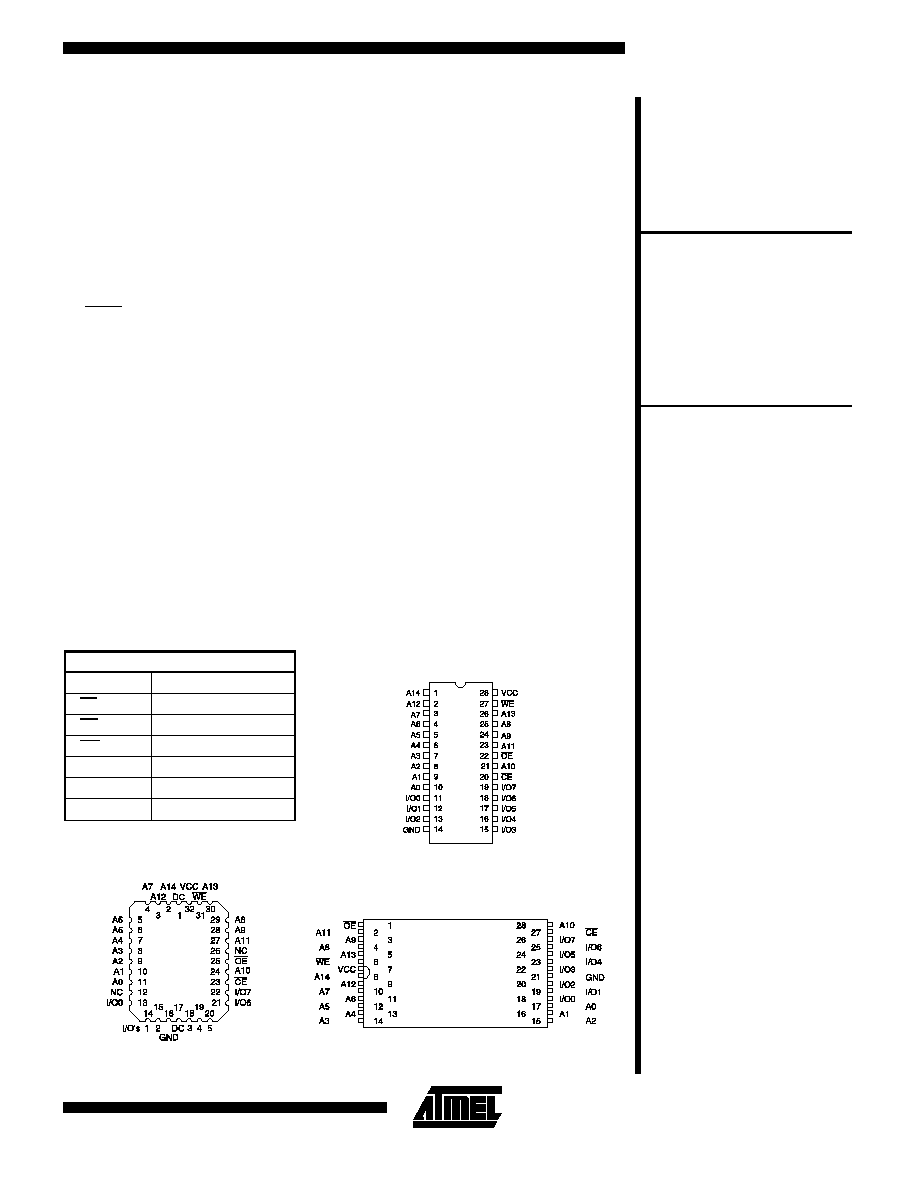 | –≠–ª–µ–∫—Ç—Ä–æ–Ω–Ω—ã–π –∫–æ–º–ø–æ–Ω–µ–Ω—Ç: AT28LV256 | –°–∫–∞—á–∞—Ç—å:  PDF PDF  ZIP ZIP |

AT28LV256
256K (32K x 8)
Low Voltage
CMOS
E
2
PROM
Features
∑
Fast Read Access Time - 200 ns
∑
Automatic Page Write Operation
Internal Address and Data Latches for 64-Bytes
Internal Control Timer
∑
Fast Write Cycle Times
Page Write Cycle Time: 10 ms Maximum
1 to 64-Byte Page Write Operation
∑
Low Power Dissipation
15 mA Active Current
20
µ
A CMOS Standby Current
∑
Hardware and Software Data Protection
∑
DATA Polling for End of Write Detection
∑
High Reliability CMOS Technology
Endurance: 10,000 Cycles
Data Retention: 10 Years
∑
Single 3.3V
±
5% Supply
∑
JEDEC Approved Byte-Wide Pinout
∑
Commercial and Industrial Temperature Ranges
Description
The AT28LV256 is a high-performance Electrically Erasable and Programmable
Read Only Memory. Its 256K of memory is organized as 32,768 words by 8 bits.
Manufactured with Atmel's advanced nonvolatile CMOS technology, the device offers
access times to 200 ns with power dissipation of just 54 mW. When the device is
deselected, the CMOS standby current is less than 200
µ
A.
The AT28LV256 is accessed like a Static RAM for the read or write cycle without the
need for external components. The device contains a 64-byte page register to allow
writing of up to 64-bytes simultaneously. During a write cycle, the addresses and 1 to
(continued)
PDIP, SOIC
Top View
Pin Name
Function
A0 - A14
Addresses
CE
Chip Enable
OE
Output Enable
WE
Write Enable
I/O0 - I/O7
Data Inputs/Outputs
NC
No Connect
DC
Don't Connect
Pin Configurations
TSOP
Top View
0273E
Note: PLCC package pins 1 and
17 are DON'T CONNECT.
PLCC
Top View
AT28LV256
2-145

Block Diagram
64-bytes of data are internally latched, freeing the address
and data bus for other operations. Following the initiation
of a write cycle, the device will automatically write the
latched data using an internal control timer. The end of a
write cycle can be detected by DATA polling of I/O7. Once
the end of a write cycle has been detected a new access
for a read or write can begin.
Atmel's 28LV256 has additional features to ensure high
quality and manufacturability. The device utilizes internal
error correction for extended endurance and improved
data retention characteristics. An optional software data
protection mechanism is available to guard against inad-
vertent writes. The device also includes an extra 64-bytes
of E
2
PROM for device identification or tracking.
Description
(Continued)
Temperature Under Bias................. -55∞C to +125∞C
Storage Temperature...................... -65∞C to +150∞C
All Input Voltages
(including NC Pins)
with Respect to Ground ................... -0.6V to +6.25V
All Output Voltages
with Respect to Ground .............-0.6V to V
CC
+ 0.6V
Voltage on OE and A9
with Respect to Ground ................... -0.6V to +13.5V
*NOTICE: Stresses beyond those listed under "Absolute Maxi-
mum Ratings" may cause permanent damage to the device.
This is a stress rating only and functional operation of the
device at these or any other conditions beyond those indi-
cated in the operational sections of this specification is not
implied. Exposure to absolute maximum rating conditions
for extended periods may affect device reliability.
Absolute Maximum Ratings*
2-146
AT28LV256

Device Operation
READ: The AT28LV256 is accessed like a Static RAM.
When CE and OE are low and WE is high, the data stored
at the memory location determined by the address pins is
asserted on the outputs. The outputs are put in the high
impedance state when either CE or OE is high. This dual-
line control gives designers flexibility in preventing bus
contention in their system.
BYTE WRITE: A low pulse on the WE or CE input with CE
or WE low (respectively) and OE high initiates a write cy-
cle. The address is latched on the falling edge of CE or
WE, whichever occurs last. The data is latched by the first
rising edge of CE or WE. Once a byte write has been
started it will automatically time itself to completion. Once
a programming operation has been initiated and for the
duration of t
WC
, a read operation will effectively be a poll-
ing operation.
PAGE WRITE: T h e p a g e w r i t e o p e r a t i o n o f t h e
AT28LV256 allows 1 to 64-bytes of data to be written into
the device during a single internal programming period. A
page write operation is initiated in the same manner as a
byte write; the first byte written can then be followed by 1
to 63 additional bytes. Each successive byte must be writ-
ten within 150
µ
s (t
BLC
) of the previous byte. If the t
BLC
limit is exceeded the AT28LV256 will cease accepting
data and commence the internal programming operation.
All bytes during a page write operation must reside on the
same page as defined by the state of the A6 - A14 inputs.
For each WE high to low transition during the page write
operation, A6 - A14 must be the same.
The A0 to A5 inputs are used to specify which bytes within
the page are to be written. The bytes may be loaded in any
order and may be altered within the same load period.
Only bytes which are specified for writing will be written;
unnecessary cycling of other bytes within the page does
not occur.
DATA POLLING: The AT28LV256 features DATA Polling
to indicate the end of a write cycle. During a byte or page
write cycle an attempted read of the last byte written will
result in the complement of the written data to be pre-
sented on I/O7. Once the write cycle has been completed,
true data is valid on all outputs, and the next write cycle
may begin. DATA Polling may begin at anytime during the
write cycle.
TOGGLE BIT: In addition to DATA Polling the AT28LV256
provides another method for determining the end of a write
cycle. During the write operation, successive attempts to
read data from the device will result in I/O6 toggling be-
tween one and zero. Once the write has completed, I/O6
will stop toggling and valid data will be read. Reading the
toggle bit may begin at any time during the write cycle.
DATA PROTECTION: If precautions are not taken, inad-
vertent writes may occur during transitions of the host sys-
tem power supply. Atmel has incorporated both hardware
and software features that will protect the memory against
inadvertent writes.
HARDWARE PROTECTION: Hardware features protect
against inadvertent writes to the AT28LV256 in the follow-
ing ways: (a) V
CC
power-on delay - once V
CC
has reached
1.8V (typical) the device will automatically time out 10 ms
(typical) before allowing a write: (b) write inhibit - holding
any one of OE low, CE high or WE high inhibits write cy-
cles; (c) noise filter - pulses of less than 15 ns (typical) on
the WE or CE inputs will not initiate a write cycle.
SOFTWARE DATA PROTECTION: A software-control-
led data protection feature has been implemented on the
AT28LV256. Software data protection (SDP) helps pre-
vent inadvertent writes from corrupting the data in the de-
vice. SDP can prevent inadvertent writes during power-up
and power-down as well as any other potential periods of
system instability.
The AT28LV256 can only be written using the software
data protection feature. A series of three write commands
to specific addresses with specific data must be presented
to the device before writing in the byte or page mode. The
same three write commands must begin each write opera-
tion. All software write commands must obey the page
mode write timing specifications. The data in the 3-byte
command sequence is not written to the device; the ad-
dress in the command sequence can be utilized just like
any other location in the device.
Any attempt to write to the device without the 3-byte se-
quence will start the internal write timers. No data will be
written to the device; however, for the duration of t
WC
,
read operations will effectively be polling operations.
DEVICE IDENTIFICATION: A n e x t r a 6 4 - b y t e s o f
E
2
PROM memory are available to the user for device
identification. By raising A9 to 12V
±
0.5V and using ad-
dress locations 7FC0H to 7FFFH the additional bytes may
be written to or read from in the same manner as the regu-
lar memory array.
AT28LV256
2-147

Symbol
Parameter
Condition
Min
Max
Units
I
LI
Input Load Current
V
IN
= 0V to V
CC
+ 1V
10
µ
A
I
LO
Output Leakage Current
V
I/O
= 0V to V
CC
10
µ
A
I
SB
V
CC
Standby Current CMOS
CE = V
CC
- 0.3V to V
CC
+ 1V
Com.
20
µ
A
Ind.
50
µ
A
I
CC
V
CC
Active Current
f = 5 MHz; I
OUT
= 0 mA
15
mA
V
IL
Input Low Voltage
0.6
V
V
IH
Input High Voltage
2.0
V
V
OL
Output Low Voltage
I
OL
= 1.6 mA
0.3
V
V
OH
Output High Voltage
I
OH
= -100
µ
A
2.0
V
DC Characteristics
AT28LV256-20
AT28LV256-25
Operating
Temperature (Case)
Com.
0∞C - 70∞C
0∞C - 70∞C
Ind.
-40∞C - 85∞C
-40∞C - 85∞C
V
CC
Power Supply
3.3V
±
5%
3.3V
±
5%
DC and AC Operating Range
Mode
CE
OE
WE
I/O
Read
V
IL
V
IL
V
IH
D
OUT
Write
(2)
V
IL
V
IH
V
IL
D
IN
Standby/Write Inhibit
V
IH
X
(1)
X
High Z
Write Inhibit
X
X
V
IH
Write Inhibit
X
V
IL
X
Output Disable
X
V
IH
X
High Z
Chip Erase
V
IL
V
H
(3)
V
IL
High
Z
3. V
H
= 12.0V
±
0.5V.
Notes: 1. X can be V
IL
or V
IH
.
2. Refer to AC Programming Waveforms.
Operating Modes
2-148
AT28LV256

AC Read Characteristics
AT28LV256-20
AT28LV256-25
Symbol
Parameter
Min
Max
Min
Max
Units
t
ACC
Address to Output Delay
200
250
ns
t
CE
(1)
CE to Output Delay
200
250
ns
t
OE
(2)
OE to Output Delay
0
80
0
100
ns
t
DF
(3, 4)
CE or OE to Output Float
0
55
0
60
ns
t
OH
Output Hold from OE, CE or
Address, whichever occurred first
0
0
ns
Notes: 1. CE may be delayed up to t
ACC
- t
CE
after the address
transition without impact on t
ACC
.
2. OE may be delayed up to t
CE
- t
OE
after the falling
edge of CE without impact on t
CE
or by t
ACC
- t
OE
after an address change without impact on t
ACC
.
3. t
DF
is specified from OE or CE whichever occurs first
(C
L
= 5 pF).
4. This parameter is characterized and is not 100% tested.
AC Read Waveforms
(1, 2, 3, 4)
t
R
, t
F
< 20 ns
Input Test Waveforms and
Measurement Level
Output Test Load
Typ
Max
Units
Conditions
C
IN
4
6
pF
V
IN
= 0V
C
OUT
8
12
pF
V
OUT
= 0V
Note: 1. This parameter is characterized and is not 100% tested.
Pin Capacitance (f = 1 MHz, T = 25∞C)
(1)
AT28LV256
2-149




